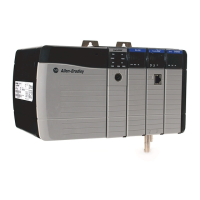Function Block Attributes
500 Rockwell Automation Publication 1756-RM006K-EN-P - November 2018
discontinuity occurs in the process output. The severity of the discontinuity
depends on the instruction and range over which DeltaT varies.
A discontinuity occurs if the following happens:
• Instruction is not executed during a scan.
• Instruction is executed multiple times during a task.
• Task is running and the task scan rate or the sample time of the process
input changes.
• User changes the time-base mode while the task is running.
• Order parameter is changed on a filter block while the task is running.
• Changing the Order parameter selects a different control algorithm within
the instruction.
Common Instruction Parameters for Timing Modes
The instructions that support time-base modes have these input and output
parameters.
Input Parameters
Input Parameter Data Type Description
TimingMode DINT Selects timing execution mode.
Value: Description:
0 Periodic mode
1 Oversample mode
2 Real time sampling mode
Valid = 0 to 2
Default = 0
When TimingMode = 0 and task is periodic, periodic timing is
enabled and DeltaT is set to the task scan rate. When
TimingMode = 0 and task is event or continuous, periodic timing
is enabled and DeltaT is set equal to the elapsed time span since
the last time the instruction was executed.
When TimingMode = 1, oversample timing is enabled and
DeltaT is set to the value of the OversampleDT parameter. When
TimingMode = 2, real time sampling timing is enabled and
DeltaT is the difference between the current and previous time
stamp values read from the module associated with the input.
If TimingMode invalid, the instruction sets the appropriate bit in
Status.
OversampleDT REAL Execution time for oversample timing. The value used for DeltaT
is in seconds. If TimingMode = 1, then OversampleDT = 0.0
disables the execution of the control algorithm. If invalid, the
instruction sets DeltaT = 0.0 and sets the appropriate bit in
Status.
Valid = 0 to 4194.303 seconds
Default = 0.0

